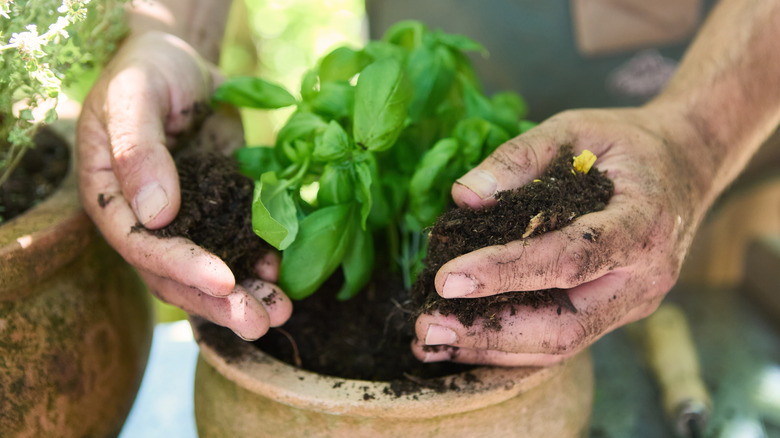How Often You Should Water Basil Plants To Keep Them Thriving All Season Long
If you've ever grown fresh basil in your garden, you know that it's one herb that doesn't mess around with its hydration. One day it's lush and fragrant, and the next, those same leaves are limp and drooping. Basil thrives on consistency, and it will show signs of stress fairly quickly if its needs aren't met, letting you know when it needs a bit of water. Too much water, on the other hand, can suffocate roots, leading to fungal problems and ruining your plant before you can enjoy that next batch of pesto. So how do you strike the perfect balance?
The key is to maintain evenly moist soil without letting it become overly soggy. Most basil plants need a thorough watering at least once a week. When summer heat ramps up, especially if your basil plant lives in an outdoor pot, watering up to daily may be necessary because containers tend to dry out faster. A good rule of thumb is to test the soil's moisture with your finger by sticking it 1 inch into the top of the soil — if it feels dry, your basil plant most likely needs a good soaking. Gardeners who grow basil plants in beds may find that mulching around the base helps retain moisture and reduces the amount of stress between watering. When growing basil indoors, be cautious about airflow and sunlight. Basil may look stunning next to a sunny window, but it can also dry out more quickly. Keeping up with consistent hydration will ensure that your basil, and any nearby companion plants alongside it, stay vibrant and aromatic throughout the growing season.
When and how to water basil for best results
Knowing when and how to water your basil plant can make all the difference in its health and flavor, ensuring a bountiful basil harvest. Always aim for the soil, not the leaves, when watering your plant. Wet foliage can encourage fungal issues that spread quickly in damp conditions. For potted basil, water slowly and evenly until you see water draining from the bottom of the container. This ensures the entire root system gets hydrated rather than just the top layer of soil. If your basil is planted in the ground, opt for deeper waterings rather than frequent, shallow ones, as this encourages stronger roots. Consider using mulch or straw to lock in moisture and regular soil temperature, especially during warmer months. These steps help reduce water-related stress, which can cause the plant to wilt or produce less flavorful leaves.
Timing is just as important as technique. The ideal time to water basil is early in the morning, giving the plant a full day to absorb moisture. Morning watering also minimizes the risk of fungal problems, as excess moisture has time to evaporate before nightfall. If mornings aren't an option for your home, late afternoon is the second-best choice. You should avoid watering in the evenings as wet roots overnight can contribute to disease and stress. During particularly dry or hot spells, you should check on your plant often for signs of drooping and adjust your watering schedule accordingly. Your basil plant will tell you when it needs water, so you'll have no problem knowing when to give it a drink.

